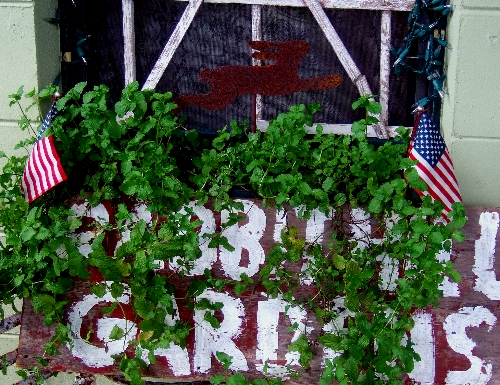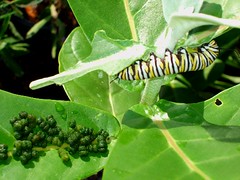Thursday, December 25, 2008
Friday, October 31, 2008
Five Things I Learned About Dogs Last Saturday Night
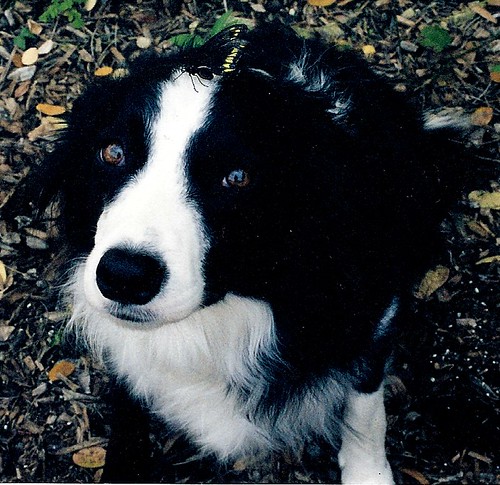
Maggie with a butterfly on her head
Five things I learned about dogs last Saturday night:
1. It’s surprisingly easy to forget that grapes are toxic to dogs until 2 seconds after yours has eaten the last bite of the leftover chicken salad Veronique you shouldn’t have given her.
2. According to various sites on the internet and the doctor answering the phone at the emergency veterinary clinic, hydrogen peroxide is the accepted method of inducing vomiting in dogs.
3. It’s easy to get the first teaspoon of hydrogen peroxide down a dog’s throat. The next few teaspoons, not so much.
4. About 20 minutes after swallowing a ¼ cup of hydrogen peroxide, a dog will expel all its previously eaten dinner along with an amazingly sticky mass of foaming goo.
5. Dogs are very quick to forgive.
Tuesday, August 12, 2008
In the Butterfy Garden: Caterpillar Predators
Customers often tell me that caterpillars they've been watching have suddenly disappeared and they wonder what could have happened to them. Sometimes they've just grown up and have gone off to pupate. But often they have become a victim of predators. Birds, of course, love a nice tasty caterpillar, but many smaller critters are predators as well. I recently captured two such predators with my camera.
This is a paper wasp devouring a monarch caterpillar. . . .
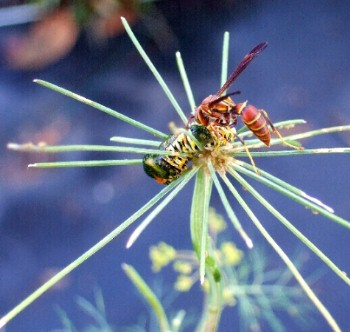
And this is what's left of a monarch caterpillar after a wasp is through with it:
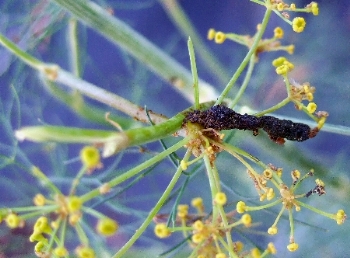
Lizards (or anoles as most of our lizards are appropriately called) eat butterfly eggs and caterpillars. Here is a lizard with an adult butterfly. It was at the end of it's life and was struggling on the sidewalk. I could see the lizard eyeing it and then grab it. It was a pretty heavy load for the lizard so I had time to run get my camera and snap this picture just before the poor butterfly was carried into the brush:
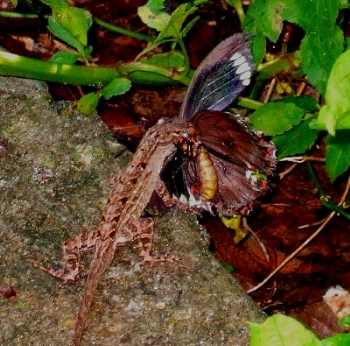
This is a paper wasp devouring a monarch caterpillar. . . .

And this is what's left of a monarch caterpillar after a wasp is through with it:

Lizards (or anoles as most of our lizards are appropriately called) eat butterfly eggs and caterpillars. Here is a lizard with an adult butterfly. It was at the end of it's life and was struggling on the sidewalk. I could see the lizard eyeing it and then grab it. It was a pretty heavy load for the lizard so I had time to run get my camera and snap this picture just before the poor butterfly was carried into the brush:

Friday, July 04, 2008
Friday, June 13, 2008
Saturday, February 16, 2008
The Old Florida Flame Vines
Thursday, February 07, 2008
Early February Butterfly Count

Red admiral on bright pink pentas
Throughout the winter I have been seeing lots of monarchs and zebra longwings, the occasional sulphur and not much else. But suddenly yesterday I saw so many butterflies appearing for the first time this year. A quick species count from the past 3 days:
blue cassius
red admiral
yellow sulphur
monarch
zebra longwing
gulf fritillary
gold rim swallowtail
Sunday, February 03, 2008
"I think using fresh herbs makes you more adventuresome in the kitchen."
Rabbit Hill Gardens and I are mentioned and quoted by Tom MacCubbin in two articles on herbs in today's Orlando Sentinel. Thanks Tom. One mistake in one article, however: it is culantro not cilantro that does well in the summer. Cilantro is a cool-weather annual like dill that bolts quickly and wilts in the heat. Culantro is a warm weather perennial that thrives in the heat and has a very similar taste.
Saturday, January 26, 2008
In the Butterfly Garden: Another Milkweed

Several years ago I started seeing growers selling giant milkweed (Calotropis gigantea) at butterfly gardening festivals. These were large plants in 3 gallon pots that sold in the neighborhood of $25. Though I had not seen any with monarch caterpillars, I was assured the giant milkweek was a good host plant. After seeing them several times, I finally broke down, purchased one and started taking cuttings. My hope was to be able to offer smaller plants at a lower price. They are not the easiest thing to propagate, but I have several going and sell them in a 1 gallon pot for $9.99.
Giant milkweed gets to be a large plant several feet high and would be great in ground here in central Florida except that our winter weather is a bit too cold. Calotropis is recommended for US zones 10B-11. We are 9B. My recommendation is to grow it in a large container and bring indoors when the temperature dips into the 30s.
The leaves of giant milkweed are large and a silvery green. The flowers come in lavender or white, though I only have the lavender. I've had plenty of flowers, but have yet to get any seed pods.
So the big question for butterfly gardeners is are they good host plants? Answer:
I've had lots of healthy monarch caterpillars on my giant milkweeds. And, as you can see, the large leaves give them more to eat than regular milkweed and also make a nice platform for collecting caterpillar poop.
Subscribe to:
Posts (Atom)
